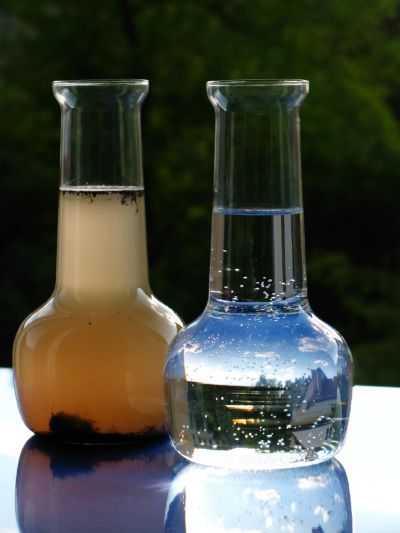
Spring has officially arrived in my part of the world, and I’m looking forward to all the beautiful blooming plants, green trees and picnics at the park. But, to maintain my garden, I’m also on the lookout for a greener garden hose.
And so begins my research.
According to
Dr. Alan Greene, a world-famous pediatrician and author of
Raising Baby Green, “Most garden hoses are made of polyvinyl chloride (PVC), and it turns out that high levels of lead additives in the PVC and in the brass fittings themselves leach easily into the water flowing through the hose, especially if the hose has been lying in the sun.
“That means that humans, pets and plants are exposed to lead, which can cause irreversible brain damage in children, if they come in contact with water from the hose. In a lawsuit settled in 2004, the country’s largest garden hose manufacturer agreed to post a warning label reading, ‘Do not drink water from this hose. Wash hands after use.’ You can make a much greener choice by replacing those old hoses with hoses labeled ‘drinking water safe.’ These are made of food-grade plastics and, in some cases, with nickel-coated fittings.”
That got me thinking: Do I really need a garden hose? Shouldn’t I be trying to conserve water instead of finding ways to use more of it? Some alarming water-flow facts:
- 884 million people in the world do not have access to safe water. This is roughly one in eight of the world’s population.
- Over the next 20 years, humans will use 40% more water than they do now. (Protected Water Fund)
- Many major rivers are running dry — the Colorado, the Ganges, the Indus, the Rio Grande and the Yellow — or are so over-tapped that they now run dry for part of the year. (Protected Water Fund)
- Freshwater wetlands have shrunk by about 50% worldwide. (Protected Water Fund)
- In 1972, the Yellow River in China failed to reach the sea for the first time in history. That year it failed on 15 days; every year since, it has run dry for a longer period of time. In 1997, it failed to reach the sea for 226 days. (Protected Water Fund)
- The U.K. has less available water per person than most other European countries. (Protected Water Fund)
- Less than 1% of the world’s fresh water (or about 0.007% of all water on earth) is readily accessible for direct human use. (Water.org)
- More than 80% of sewage in developing countries is discharged untreated, polluting rivers, lakes and coastal areas. (Water.org)
All things considered, a rain barrel might be a better option than a garden hose.
Rain water harvesting decreases the demand for domestic water. And by collecting rain water and storing it a rain barrel I’ll have water for future use, whether it’s for watering the garden or just keeping it handy for emergency situations.
 Spring has officially arrived in my part of the world, and I’m looking forward to all the beautiful blooming plants, green trees and picnics at the park. But, to maintain my garden, I’m also on the lookout for a greener garden hose.
And so begins my research.
According to Dr. Alan Greene, a world-famous pediatrician and author of Raising Baby Green, “Most garden hoses are made of polyvinyl chloride (PVC), and it turns out that high levels of lead additives in the PVC and in the brass fittings themselves leach easily into the water flowing through the hose, especially if the hose has been lying in the sun.
“That means that humans, pets and plants are exposed to lead, which can cause irreversible brain damage in children, if they come in contact with water from the hose. In a lawsuit settled in 2004, the country’s largest garden hose manufacturer agreed to post a warning label reading, ‘Do not drink water from this hose. Wash hands after use.’ You can make a much greener choice by replacing those old hoses with hoses labeled ‘drinking water safe.’ These are made of food-grade plastics and, in some cases, with nickel-coated fittings.”
That got me thinking: Do I really need a garden hose? Shouldn’t I be trying to conserve water instead of finding ways to use more of it? Some alarming water-flow facts:
Spring has officially arrived in my part of the world, and I’m looking forward to all the beautiful blooming plants, green trees and picnics at the park. But, to maintain my garden, I’m also on the lookout for a greener garden hose.
And so begins my research.
According to Dr. Alan Greene, a world-famous pediatrician and author of Raising Baby Green, “Most garden hoses are made of polyvinyl chloride (PVC), and it turns out that high levels of lead additives in the PVC and in the brass fittings themselves leach easily into the water flowing through the hose, especially if the hose has been lying in the sun.
“That means that humans, pets and plants are exposed to lead, which can cause irreversible brain damage in children, if they come in contact with water from the hose. In a lawsuit settled in 2004, the country’s largest garden hose manufacturer agreed to post a warning label reading, ‘Do not drink water from this hose. Wash hands after use.’ You can make a much greener choice by replacing those old hoses with hoses labeled ‘drinking water safe.’ These are made of food-grade plastics and, in some cases, with nickel-coated fittings.”
That got me thinking: Do I really need a garden hose? Shouldn’t I be trying to conserve water instead of finding ways to use more of it? Some alarming water-flow facts: